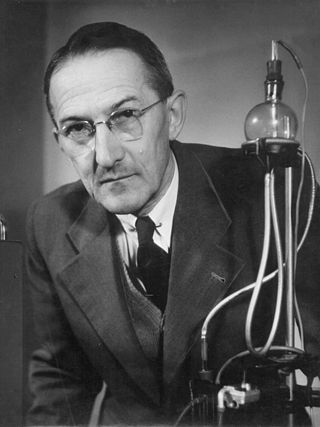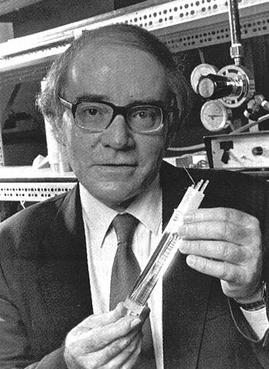Robert J. Forster is a professor of Physical Chemistry at Dublin City University. He is a member of the Royal Irish Academy. [1]
Robert J. Forster is a professor of Physical Chemistry at Dublin City University. He is a member of the Royal Irish Academy. [1]
Forster has authored many research papers in leading international journals in chemistry. [2] His research has focused on attempts to create new materials with useful electronic or photonic properties, to create new experimental techniques to discover chemical reactivity under extreme conditions and at short timescales and to find theoretical insights into factors influencing electron transfer. His work has implications for a wide variety of areas which include the following: corrosion, biological membranes, the emerging area of molecule-based electronics and heterogeneous catalysis. [3]
In addition to many published articles Forster was joint author of the book:
And joint author of the following book chapters

A chemist is a scientist trained in the study of chemistry. Chemists study the composition of matter and its properties. Chemists carefully describe the properties they study in terms of quantities, with detail on the level of molecules and their component atoms. Chemists carefully measure substance proportions, chemical reaction rates, and other chemical properties. In Commonwealth English, pharmacists are often called chemists. The origin of the word "Chemistry" is in Iran, which is pronounced as kîmiya. And "Chemist" is called kîmiya-gar.

Jaroslav Heyrovský was a Czech chemist and inventor. Heyrovský was the inventor of the polarographic method, father of the electroanalytical method, and recipient of the Nobel Prize in 1959 for his invention and development of the polarographic methods of analysis. His main field of work was polarography.

The Royal Irish Academy, based in Dublin, is an academic body that promotes study in the sciences, humanities and social sciences. It is Ireland's premier learned society and one its leading cultural institutions. The Academy was established in 1785 and granted a royal charter in 1786. As of 2019, the RIA has around 600 members, regular members being Irish residents elected in recognition of their academic achievements, and Honorary Members similarly qualified but based abroad; a small number of members are elected in recognition of non-academic contributions to society.

Richard Neil Zare is the Marguerite Blake Wilbur Professor in Natural Science and a Professor of Chemistry at Stanford University. Throughout his career, Zare has made a considerable impact in physical chemistry and analytical chemistry, particularly through the development of laser-induced fluorescence (LIF) and the study of chemical reactions at the molecular and nanoscale level. LIF is an extremely sensitive technique with applications ranging from analytical chemistry and molecular biology to astrophysics. One of its applications was the sequencing of the human genome.
Izaak Maurits (Piet) Kolthoff was an analytical chemist and chemistry educator. He is widely considered the father of analytical chemistry for his large volume of published research in diverse fields of analysis, his work to modernize and promote the field, and for advising a large number of students who went on to influential careers of their own.

Richard Guy Compton FRSC MAE is Professor of Chemistry and Aldrichian Praelector at Oxford University, United Kingdom. He is a Tutorial Fellow of St John’s College, Oxford and has a large research group based at the Physical and Theoretical Chemistry Laboratory at Oxford University. Compton has broad interests in both fundamental and applied electrochemistry and electro-analysis including nano-chemical aspects. He has published more than 1600 papers with more than 44,000 citations, excluding self-cites, as of March 2020; Reuters-Thomson ‘Highly Cited Researcher’ 2014, 2015 and 2016) and 7 books.
The Electrochemical Society is a learned society based in the United States that supports scientific inquiry in the field of electrochemistry and solid-state science and related technology. The Society membership comprises more than 8,000 scientists and engineers in over 85 countries at all degree levels and in all fields of electrochemistry, solid state science and related technologies. Additional support is provided by institutional members including corporations and laboratories.

Allen Joseph Bard is an American chemist. He is the Hackerman-Welch Regents Chair Professor and director of the Center for Electrochemistry at the University of Texas at Austin. Bard is considered a "father of modern electrochemistry" for his innovative work developing the scanning electrochemical microscope, his co-discovery of electrochemiluminescence, his key contributions to photoelectrochemistry of semiconductor electrodes, and co-authoring a seminal textbook.

John William Mallet FRS was an Irish chemist who lived and worked in the United States.
Dermot Moran is an Irish philosopher specialising in phenomenology and in medieval philosophy, and he is also active in the dialogue between analytic and continental philosophy. He is currently the inaugural holder of the Joseph Chair in Catholic Philosophy at Boston College. He is a member of the Royal Irish Academy and a founding editor of the International Journal of Philosophical Studies.

Martin Fleischmann FRS was a British chemist who worked in electrochemistry. Premature announcement of his cold fusion research with Stanley Pons, regarding excess heat in heavy water, caused a media sensation and elicited skepticism and criticism from many in the scientific community.
Johannes G. Vos, also known as Han Vos is Emeritus Professor of Inorganic Chemistry at Dublin City University in Ireland.
Tia Emmetine Keyes is a professor of physical chemistry at the School of Chemical Sciences, and a member of the National Centre for Sensor Research at Dublin City University.

Maria Baghramian is an Irish philosopher who is the Professor of American Philosophy in the School of Philosophy, University College Dublin (UCD). She was elected a member of the Royal Irish Academy (RIA) in 2010 and a member of the RIA Council from 2015 to 2018. Baghramian has published ten authored and edited books as well as articles and book chapters on topics in epistemology and twentieth century American Philosophy. She was the Chief Editor of the International Journal of Philosophical Studies (IJPS) from 2003 to 2013.
Armando José Latourrette de Oliveira Pombeiro is a Portuguese chemical engineer.
The Castner Gold Medal on Industrial Electrochemistry is an biennial award given by the Electrochemical Technology Group of Society of Chemical Industry (SCI) to an authority on applied electrochemistry or electrochemical engineering connected to industrial research. The award is named in honor of Hamilton Castner, a pioneer in the field of industrial electrochemistry, who patented in 1892 the mercury cell for the chloralkali process. Castner was an early member of SCI.
Priscilla Baker is a professor of analytical chemistry at the University of the Western Cape. She is the co-leader of SensorLab, a research platform in electrochemistry that deals with the electrodynamics of materials and sensors. She is an active member of the Academy of Science of South Africa, European Scientific Network for Artificial Muscles (ESNAM) and the Marie Curie International staff exchange scheme (IRSES).

Dennis Gail Peters was an American analytical chemist who specialized in electrochemistry and was named the Herman T. Briscoe Professor at Indiana University in 1975. Peters led his own research group at Indiana University in Bloomington, Indiana until his death in 2020. Peters' research focused on the electrochemical behavior of halogenated organic compounds, more recently moving to focus on transition metal catalysts in regards to the oxidation and reduction of organic species. He authored or co-authored over 210 publications and 5 analytical chemistry textbooks.
Héctor Daniel Abruña is a Puerto Rican physical chemist whose work focuses on electrochemistry, molecular electronics, fuel cells, batteries, and electrocatalysis. Abruña is director of the Energy Materials Center and Emile M. Chamot professor for chemistry at Cornell University. He became a Fellow of the American Association for the Advancement of Science in 2006, a Member of the American Academy of Arts and Sciences in 2007, and a Member of the National Academy of Sciences in 2018. Abruña conducts research into battery and fuel cell systems using electrochemical techniques and X-ray microscopy and spectroscopy methods.

Spectroelectrochemistry (SEC) is a set of multi-response analytical techniques in which complementary chemical information is obtained in a single experiment. Spectroelectrochemistry provides a whole vision of the phenomena that take place in the electrode process. The first spectroelectrochemical experiment was carried out by Theodore Kuwana, PhD, in 1964.